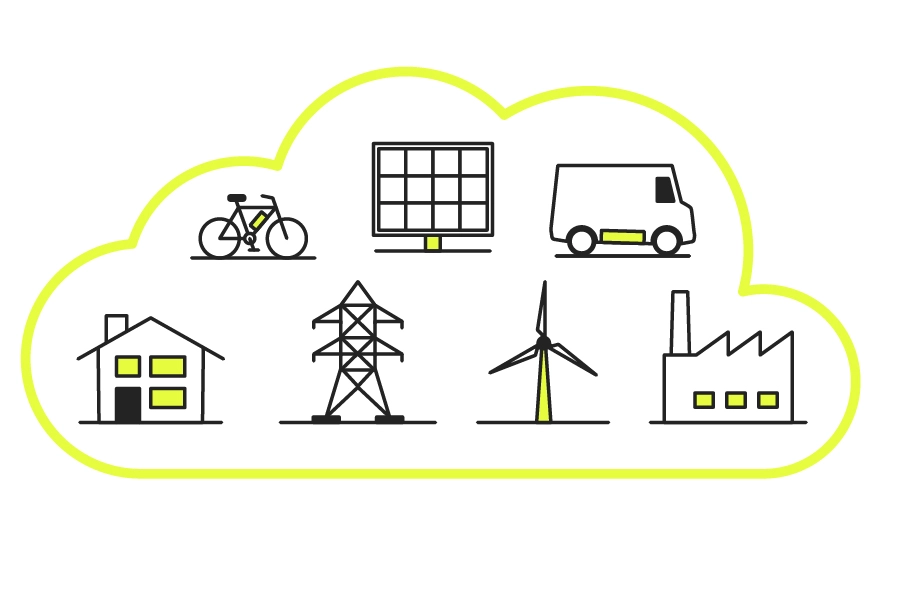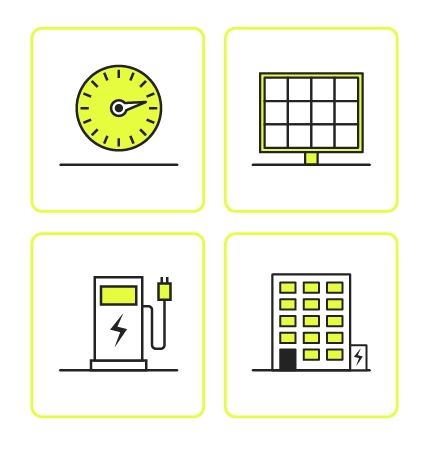Intelligently designed
charging infrastructure
Charging infrastructure is the backbone of the mobility transition. However, its current expansion - with charging points directly connected to the public electricity grid - will soon reach its limits: Building connections and the electricity grid have to be adapted to the rapidly increasing demand, at considerable expense in terms of money, resources and, not least, time. Battery buffers can help to make the expansion of the charging infrastructure better and faster. They store electricity when it is cheaply available and release it with high power when it is needed. But their benefits go far beyond that - at least when batteries are part of an integrated, intelligently dimensioned overall solution.
A wealth of new possibilities

A wealth of new possibilities
Batteries are true multi-talents. Why only temporarily store charging power when the same battery can also help to increase self-consumption of photovoltaic power or shave peak loads? This is not only worth money, but also helps to integrate wind and solar power into the energy system of the future. For another secondary use of batteries, this is especially true: the provision of balancing power in the public electricity grid. Therefore, our vision is to use batteries in their versatility in the best possible way to make the mobility transition economical, resource-saving and feasible. But even if it's just a matter of fast charging points in employee or customer car parks: charging infrastructure with battery storage is mostly the better option, with the potential for more.
Batteries are true multi-talents. Why only temporarily store charging power when the same battery can also help to increase self-consumption of photovoltaic power or shave peak loads? This is not only worth money, but also helps to integrate wind and solar power into the energy system of the future. For another secondary use of batteries, this is especially true: the provision of balancing power in the public electricity grid. Therefore, our vision is to use batteries in their versatility in the best possible way to make the mobility transition economical, resource-saving and feasible. But even if it's just a matter of fast charging points in employee or customer car parks: charging infrastructure with battery storage is mostly the better option, with the potential for more.
Rightsizing - What is that?

Rightsizing - What is that?
Oversizing means wasting resources - financially as well as in terms of raw materials. This applies not least to batteries. That is why the intelligent design of the charging infrastructure, including buffer storage, is so important to us. For excellent performance and the best economy, a surprisingly small battery is often enough. Not every kilowatt hour of charging current has to flow through the storage unit if the public grid and your own PV electricity are available in parallel. And not every kilowatt hour of stored electricity has to be used for charging if secondary use is also attractive in parallel. Therefore, intelligent system design is a science in itself, and our design is scientifically sound - with tools from Fraunhofer research.
Oversizing means wasting resources - financially as well as in terms of raw materials. This applies not least to batteries. That is why the intelligent design of the charging infrastructure, including buffer storage, is so important to us. For excellent performance and the best economy, a surprisingly small battery is often enough. Not every kilowatt hour of charging current has to flow through the storage unit if the public grid and your own PV electricity are available in parallel. And not every kilowatt hour of stored electricity has to be used for charging if secondary use is also attractive in parallel. Therefore, intelligent system design is a science in itself, and our design is scientifically sound - with tools from Fraunhofer research.
